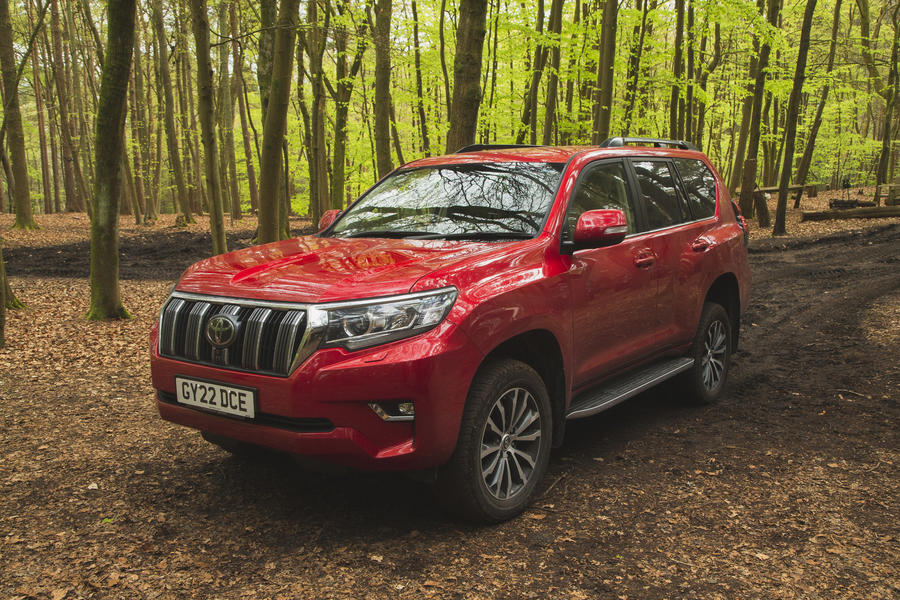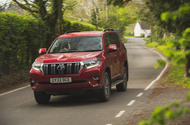Has modernity failed us? We’re revisiting the old ways in this off-road icon to find out
Why we’re running it: What lessons can be learned from running a Toyota Land Cruiser, the most old-school of current offerings?
Month 1 – Specs

Life with a Toyota Land Cruiser: Month 1
Welcoming the Land Cruiser to the fleet – 17 May 2023
You’ve never driven off-road?! Not even once?!” an incredulous Piers Ward exclaimed over the airwaves from his home in rural Lincolnshire. “No, because there are roads where I want to go,” came my cheeky reply from a Sussex suburb.
Our associate editor was calling to deliver the news that my wee Yaris Cross was going to be swapped for a gigantic Land Cruiser – two Toyotas seemingly from different universes.
Land Cruisers being as rare as Ward’s favoured flat caps around here and the possibility of meeting a mamba appealing to me about as much as catching Covid, I had never fully appreciated this 4×4’s popularity or depth of lore.
Since 1951, Toyota has sold more than 10 million Cruisers – enough for every person in London today with plenty to spare. Many of those have ended up in Africa and Australia, but they’re also popular in South America and the Middle East – basically, anywhere you need the off-road ability of a Land Rover without the associated reliability concerns. The one complication is there isn’t just one Land Cruiser.
Most places, but very few of them in Europe, have the J300, released in 2021. Over here, we get what they know as the Land Cruiser Prado, which is smaller and which has been in its J150 generation since 2009, its second facelift coming in 2017. And in really hardcore places, like Chile, Namibia and Canada, there are also Land Cruisers 76, 78 and 79, variants of the J70 that has been in production since 1984. The same year the Mercedes-Benz W124 and Ferrari Testarossa were born…
So why are we running a Land Cruiser now, in 2023? I won’t even pretend it’s to see if it can function as a city car or a good commuter, for obvious reasons. Instead, we’re doing so because it’s perhaps the most anachronistic car sold by a mainstream manufacturer today and seems to be made more so by the day as everything else becomes electrified, connected and autonomous, which makes it a real curio, an item of rare interest. I guess this is what you get when you write articles about the 1920s (see p66) and wear a baseball cap that reads ‘modernity has failed us’…
I began to question that as I stepped into my behemoth of a seven-seater for the first time, having noted the ladder-frame construction through the gaping gap between 23in all-terrain tyre and bulky body as I jumped from the running board into an ivory leather chair; was met by a dash looking like a hi-fi you would find in Oxfam; touched yet more leather and Earth’s smoothest wood trim; and then read a spec sheet alerting me to the presence of a 2.8-litre four-pot that would get just 29mpg. On diesel. At £1.70 per litre…
I have tested many SUVs, but most of those were front-driven crossovers, and even the Land Rovers I’ve driven have had a monocoque at least. The Land Cruiser is something else entirely, I realised as it grumbled into loud life, sat back on its big bum and floated lazily out of Toyota’s fleet garage, my steering inputs are seemingly taken as more approximations than directions.
Get this, though: I was laughing like an idiot. So homogenous and characterless are many cars these days that I loved finding a new way to drive and seeing controls and features that were totally unfamiliar. How’s a button for manual diesel particulate filter cleaning, an off-roading console or a central bin that can function as a fridge, for instance? I would like the touchscreen’s Apple CarPlay to be wireless for my £64,150, but otherwise Invincible spec (sitting above only Active trim) brings everything any countryside dweller could need.
In terms of old-school luxuries, I have said fridge, electric seat adjustment, a parking camera, parking sensors, automatic headlights, tri-zone air conditioning, powered mirrors, a heated and electrically adjustable steering wheel and comfy chairs with ventilation and heating and upholstered in Ortaka Ivory leather (the same colour as the carpet).
As for off-road features, I have Multi-Terrain Select (five off-road driving modes), cameras looking underneath the car, crawl control (a kind of off-road cruise control), a body angle display, a steering angle display, off-road turning assistance, a rear Torsen differential, a locking centre differential and Toyota’s fascinating Kinetic Dynamic Suspension System, which senses whether you are on or off-road and then hydraulically optimises the anti-roll bars accordingly.
And among the modern technology, I have a 9.0in infotainment touchscreen with Apple CarPlay, Android Auto and sat-nav, a punchy 14-speaker JBL stereo, adaptive cruise control, lane departure alert, traffic sign recognition, automatic high beam, automatic wipers, rear cross-traffic alert, automatic emergency braking with pedestrian detection and blindspot monitoring.
I may have been the butt of many jokes since being handed the keys to the Land Cruiser for the juxtaposition of my car and my lifestyle, but I’m already feeling like I’m making a new friend, I’ve booked a course to learn how to off-road (that you can read about here in the coming weeks) and I’ve even made one of my neighbours envious. Surprise, surprise, she’s a travelling equine vet.
Second Opinion
The Land Cruiser might still be my favourite all-round versatile passenger 4×4, aside from the Jeep Wrangler, which does something slightly different. That’s a hobby car, this is a practical, all-conditions wagon that can tow all day, or off-road all day, or sit on a motorway all day, and feels like it will do any of those things basically forever. Easy to take for granted
Matt Prior
Toyota Land Cruiser 2.8 D4-D Invincible specification
Specs: Price New £64,150 Price as tested £64,880 Options
Test Data: Engine 2.8-litre 4cly diesel Power 204bhp Torque 369lb ft Kerb weight 2135kg Top speed 109mph 0-62mph 12.7sec Fuel economy 30.5mpg CO2 246g/km Faults None Expenses None
Source: Autocar
